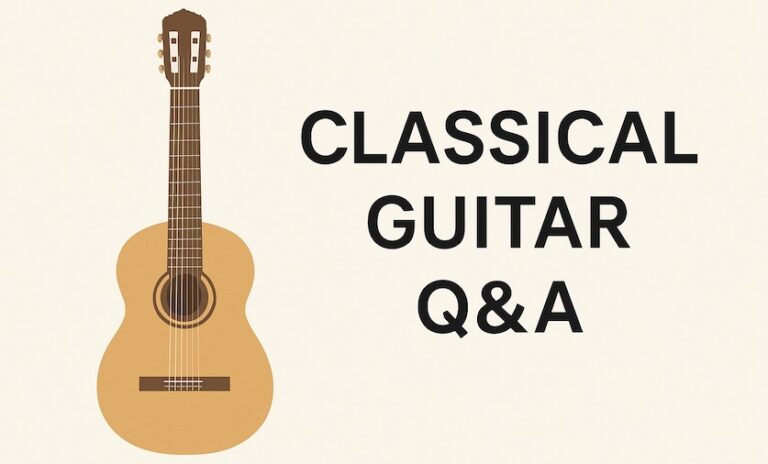This routine is from my new book Classical Guitar Technique: Essential Exercises, Scales, and Arpeggios. The 122 page book includes: Practice Routines, Tips, 100 Open String Exercises, 120 Giuliani Arpeggios, Scales, Slur Exercises, Shifts, Finger Independence, Barre, Tremolo, Common Harmonics, and much more. YouTube Video Link (4k)
This is Part 3 of a 6 Part Lesson Series on technique routines. This is for early-intermediate, so maybe for someone who has finished both of my Volume 1 and 2 method books or equivalent. View all the free routine videos at the book page. You can use other books if you want but make sure to keep it balanced as I discuss. Also, grab some sticky tabs and mark the pages in my book so you can easily flip through. The levels to covered in the 6 part series are: Beginner; Late-Beginner; Early-Intermediate; Intermediate; Late-Intermediate; Early-Advanced.
Time Management Problems? Too much material? Remember to stay focused on the core elements of Scales, Arpeggios, Slurs, and Barre. If you can get a little of each in every practice session then you are doing well. For the open string exercises, first go through all of them and make sure you can play each one at a reasonable speed. Do only one of them during a session if needed. Check them off as you go. Once you’ve covered them all, focus on a select few that give you trouble. After that you can probably just play the Giuliani Arpeggios to save time. Pretty much the same advice for all the sections, go through everything, focus on your weaknesses and make them your strengths.
Early-Intermediate Routine
- Length: Approximately 20 Minutes
- Open String Exercises No. 1-96 – Omit three-finger melodic patterns (No. 6, 7, 8, 16)
- Giuliani Arpeggios No. 1-16 and No. 81-88
- Alignment Exercises (pages 54-57)
- Chromatic Scales (page 58)
- First Position Major Scales (pages 64-65)
- First Position Melodic Minor Scales (pages 66-67)
- One Octave Movable Scales (pages 68-69)
- Slurs (pages 81-83) • Finger Independence (pages 93-97)
- Barre (pages 106-108)




Giuliani. They are billed as exercises for the right hand, but 90% of the difficulty is cleanly fretting that horrible G7. For any early player, surely it would be better to susbstitute it with something easier?
Well, you can practice the right hand pattern on open strings but shapes such as the G7 do come up often in classical guitar so maybe something is a millimetre off in your left hand alignment or position overall. Investigate with left hand independence and stretch.
Thanks for that. I did a bit of research and found that I am not alone in this. People have taken years to master this G7. I find it hard to believe that anyone can do this without interference. I’ve just cut my nails painfully short and shall try again. It’s a shame that this detracts from the purpose of the exercise. I shall not be defeated though 🙂
Whenever something like this comes up in my teaching, I assign the student either open strings or different chords. But I make a note of it and be sure to address the chord shape separately so it doesn’t hold back progress in the right hand. You always just need to find a way to move forward while not forgetting to clear up issues.
Heh. Went to see David Russel the other night (in Córdoba). I sat in the front row, as usual, and was watching his hands. He’s 72 and you’d think he’d be having joint problems by now, but that left hand is amazing. I expect you’re the same, but I haven’t watched you so closely. He can fret top and bottom strings without even slightly bending the wrist. I’ll bet he can fret the G7 in his sleep. It’s inspiring.
OK. Here’s a puzzler. No. 86 in the arpeggio set. Thumb on low E and triplets with ima. I instinctively started doing this by planting the fingers. But then I found my coordination was way off. Stopped planting and all well. Why’s that then? What’s going on?
I recommend practicing both way. It’s likely just a gap or lapse in your technique muscle memory, everyone has/gets them including me. It’s a good thing when you find one as you know that is something good to work on. Brain to finger coordination on fine levels is great practice.
Quite enjoying this. Done most of it before, so brushing up. Doing a couple of pages of this, before scales C to F# (Segovia) and finish off with a quick run through Greensleeves. Off to play piano now 🙂
Great to hear! Happy practicing.
Ah, just read this bit: “Time Management Problems? Too much material?”
As you were…
Hello again Bradford. I don’t know if I’m being a bit dime here – I can’t relate 20 minutes with 96 exercises repeated 8 times for each of the finger patterns. This is going to take me hours.